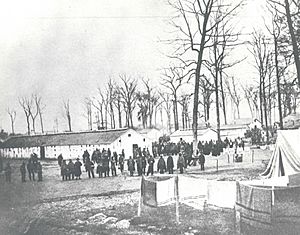Bounty jumper facts for kids
Imagine someone joining a team just to get a prize, then quickly leaving. That's a bit like what bounty jumpers did during the American Civil War. These were men who signed up to fight for either the Union (the North) or the Confederate (the South) armies. Their main goal was to collect a special payment called a 'bounty' – a reward for joining. After getting the money, they would often leave the army very quickly.
During the war, a law called the Enrollment Act of 1863 started 'conscription,' which meant people could be forced to join the army. But it also allowed people to pay someone else to fight instead of them. Bounty jumpers took advantage of this. They would often join the army many times, collecting a new bounty each time they signed up.
Contents
How Bounty Jumpers Operated
It was usually more profitable to be a bounty jumper in the North. About a month after the Battle of Fort Sumter, the United States Congress passed a law. This law allowed for bounties of up to $300. The Confederate government also offered bounties, starting at $50 and later increasing to $100.
The US dollar was worth more than the Confederate dollar. This meant the Northern government had more success with bounties. They also had more problems with bounty jumpers. State and local governments sometimes added to these bounties. This could make the total amount as much as $1000. This was a lot of money, especially since a typical Northern soldier earned only $13 a month.
A bounty jumper would usually leave his unit before reaching the battlefront. He would then travel to a new area to collect another bounty. One bounty jumper collected at least 32 bounties. Another, known as John Larney or "Mollie Matches," claimed to have joined and deserted 93 times.
What Happened to Bounty Jumpers?
Because so many bounty jumpers were taking advantage of the system, the Confederate Congress changed the law. In December 1863, they stopped allowing people to pay others to fight in their place.
Not all bounty jumpers successfully escaped their units. During the Battle of Spotsylvania Court House in 1864, one bounty jumper caused a problem. He was part of the 35th Massachusetts Regiment. He yelled "Retreat!" which made his whole unit panic and run back to their defensive positions.
New York City was a popular place for bounty jumpers to go. At one point, it was believed that 3,000 professional bounty jumpers were in the city. In February 1863, a short effort to catch jumpers found a dozen every day.
Later in the war, a detective named Lafayette Baker caught many bounty jumpers. He used a fake recruitment office with help from a broker named Theodore Allen. In one day, Baker caught 183 bounty jumpers. However, Allen later ran off to Canada with $50,000 that was meant to catch the jumpers.
Famous Bounty Jumpers
One bounty jumper became very famous. His name was Adam Worth. He later became an international thief. His most famous crime was stealing Thomas Gainsborough's painting, Duchess. He became known as the "Napoleon of Crime." Sir Arthur Conan Doyle used this idea to create the character Professor Moriarty. Moriarty was loosely based on Worth.
According to William Pinkerton, Worth did fight once for the Union. This was at the Battle of the Wilderness. He also once collected a $30 Confederate bounty, but then fought for the Union. Pinkerton said Worth acted out of greed, not because he was a coward.
People in the North generally looked down on bounty jumpers. They saw them as dishonest and cowardly. This widespread view meant that Northern authorities often punished bounty jumpers more severely than other deserters.
Punishments for Bounty Jumpers

Bounty jumping could lead to very serious punishments, even the death penalty. A notable execution of bounty jumpers happened in Beverly Ford, Virginia, on August 29, 1863. Five bounty jumpers had been caught after leaving the 118th Pennsylvania "Corn Exchange" Regiment. They were sentenced to death.
Appeals were sent to President Abraham Lincoln. Lincoln decided that bounty jumping was becoming too big a problem. He denied the appeal. The execution of the five deserters took place with the entire V Corps watching. In 1864, three bounty jumpers were executed at Camp Morton in Indianapolis.
At Governors Island in early 1865, a bounty jumper named James Develin was executed. His wife had turned him in after finding him with another woman. Bounty jumpers were more likely to face death sentences than other deserters. This included those who left because they missed home or needed to help their families. In another event, a bounty jumper trying to escape was shot by his captors.
Not all punishments were the death penalty. When a man who had bounty jumped 32 times was caught, he was sentenced to four years in prison. The famous Andersonville prison held hundreds of bounty jumpers.


